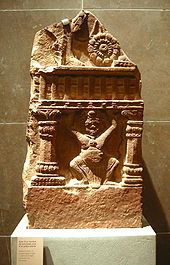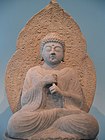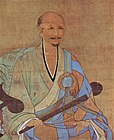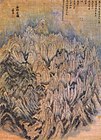History of Asian Art

The history of Asian art , sometimes also Far Eastern art , encompasses many influences from diverse cultures and religions. Historically, artistic developments are parallel or, in general, even several centuries earlier than in Western art. Chinese art , Indian art, Korean art , and Japanese art each had a great influence on Western art and vice versa. Persian art and Islamic art also influenced Western art.
Balinese art
As a Balinese art Art is with Hindu - Javanese designated origin that has its roots in the work of artists of the kingdom of Majapahit and their spread to Bali has in the late 13th century. From the 16th to the 20th centuries, the village of Kamasan, Klungkung (East Bali) was the center of classical Balinese art. In the first half of the 20th century, new varieties of Balinese art developed and since the late 20th century the village of Ubud and its neighboring villages have been considered the centers of Balinese art. Ubud and Batuan are famous for their paintings, Mas for their wood carvings, Celuk for their gold and silversmithing and the village of Batubalan has unique stone carvings. Covarrubias describes Balinese art as “... a highly developed, albeit informal, baroque folk art that combines peasant liveliness with the subtleties of Hindu-Javanese classical music, but free from conservative prejudices and with a new zest for life that is fueled by the demonic spirit of tropical primitiveness is ". Eisenman correctly described that Balinese art mainly embellishes objects that are intended for everyday use and hardly produce pure works of art.
In the 1920s, with the arrival of many Western artists, Bali became a kind of artist enclave for avant-garde artists, for example Walter Spies (Germany), Rudolf Bonnet (Netherlands), Adrien-Jean Le Mayeur (Belgium), Arie Smit (Netherlands) and something later also Donald Friend (Australia). Many of these Western artists had very little influence on the people of Bali until the end of World War II.
The groundbreaking period of Balinese creativity peaked in the late 1930s. A stream of famous visitors, including Charlie Chaplin , anthropologist Gregory Bateson, and Margaret Mead , encouraged talented locals to create highly original works. During their stay in Bali in the mid-1930s, Bateson and Mead collected over 2000 paintings, mainly from the village of Batuan, but also from the coastal town of Sanur. Spies and Bonnet are often cited as being primarily responsible for the modernization of traditional Balinese painting. From the 1950s onwards, Balinese artists incorporated perspective and anatomical aspects of their work into their works. They also acted as pioneers by encouraging locals to experiment and deviate from traditions. The result was an explosion of individual expressions that drove up the number of profound changes within Balinese art.
Bhutanese art
Bhutanese art is more similar to the art of Tibet . Both are based on the Vajrayana - Buddhism , with its pantheon of divine beings.
Every divine being has specially assigned shapes, colors and / or identifying objects, such as the lotus, the snail shell, the lightning bolt or the begging bowl. All sacred images are made to precise specifications, most of which have not changed for centuries.
The main lines of Buddhism in Bhutan are Drugpa-Kagyu and Nyingma . The former is a branch of the Kagyu School and is known for its paintings that document the lineage of Buddhist masters and the 70 Je Khenpo (heads of the central monastic body of Buthan). The Nyingma school is known for images of Padmasambhava , who is responsible for the introduction of Buddhism in Bhutan in the 7th century. Legend has it that Padmasambhava hid sacred treasures so that they could be found by future Buddhist masters such as Pema Lingpa . The Tertön (treasure hunters) are a common theme in Nyingma art.
Bhutanese art is particularly rich in bronze statues of various types, commonly known as Kham-so (meaning: made in Kham ). This name originated from the production method imported into Bhutan from the province of Kham in Tibet . Wall paintings and sculptures from these regions are designed according to the principally timeless ideals of Buddhist art, and although the emphasis on details is derived from Tibetan art, it is easy to distinguish the origin of the work of art. The artists had greater freedom than in the representation of divine beings in the representation of the grotesque world of demons; here there are portraits with abundantly embroidered robes and glittering ornaments that stretch over the figures shown.
The traditional Bhutanese arts and crafts disciplines, which represent the exclusive "soul and identity of the kingdom in the Himalayas", are summarized under the term Zorig Chosum . Zorig Chosum means "the 13 arts and crafts disciplines from Bhutan", meaning carpentry, painting, papermaking, blacksmithing, weaving, sculpture and a few others. In Thimpu , the government of Bhutan has established the Institute for Zorig Chosum , whose sole aim is to teach students these 13 art forms and thus preserve the rich culture and tradition of Bhutan. There is a second similar institute in the Trashiyangtse district in eastern Bhutan. In Thimphu there is also a 'Folk Art Museum' that illustrates rural life in Bhutan and the 'Voluntary Artists Studio', an art NGO that brings children and young people closer to traditional art forms and encourages them to pursue them.
Buddhist art
Chinese art
Indian art

Indian art can be divided into several periods, each of which can also be found in certain religious, political and cultural developments. The earliest examples of Indian art are so-called petroglyphs , such as those from Bhimbetka . Some of these petroglyphs originated as early as 5500 BC. BC, others centuries later. More recent examples of Indian art are the carved columns of Ellora , Maharashtra or the frescoes in Ajanta and the caves of Ellora .
Special periods:
- Hinduism and Buddhism of the ancient period (3500 BC to the present day)
- Islamic ascent (712–1757 AD)
- The colonial period (1757–1947 AD)
- Independence and the Post-Colonial Period (after 1947)
- Modern and Postmodern Art in India
One of the most popular art forms in India is called Rangoli and it is a form of the sand picture . Colored, finely grated powder is arranged to form pictures; such pictures are usually found outdoors.
The visual arts (sculpture, painting and architecture) are closely linked to the other art forms in Indian art. Kapila Vatsyayan describes this as follows: “Classical Indian architecture, sculpture, painting, literature (Kaavya), music and dance have developed their own rules, depending on the medium of expression, but they not only share the underlying beliefs of the Indian religious-philosophical But also the procedures by which the relationships between symbols and the state of mind are worked out in detail. "
The best way to gain insight into the unique characteristics of Indian art is to understand the philosophical thought, the wide-ranging cultural history, and the social, religious and political background of the individual works of art.
Indonesian art

The Indonesian art and culture has been shaped by a long interaction between traditional indigenous customs and different foreign influences. Due to the central location of Indonesia on important ancient trade routes between the Far and Middle East, a strong influence of Eastern religions developed. Hinduism , Buddhism , Confucianism and Islam had a high status in the big trading cities. A complex cultural mix emerged that is very different from the original indigenous culture of Indonesia.
Indonesian paintings are largely unknown, with the exception of the complicated and expressive Balinese paintings, which often show natural scenes or themes from traditional dance. Paintings of the indigenous Kenyah also show, as is usual among Austronesian cultures, natural motifs, predominantly ferns, trees, dogs, hornbills or human figures. Examples of such paintings can still be found in Kenyah Dayak longhouses in the Apo Kayan region of Kalimantan Timur .
Calligraphy, based on the Koran , was often used as decoration among Muslims, as Islam forbids naturalistic representations. Indonesia also has a large number of bronze and iron sculptures; the production of these was particularly popular in the 8th to 10th centuries AD. The sculptures were also often integrated into the decoration of temples.
One of the most impressive Indonesian works of art is the hundreds of meters long relief sculpture of the temple in Borobodur in Central Java . A little more than 3 kilometers of relief tell the story of Gautama Buddha and illustrate his teachings. The temple was also home to 504 seated Buddha statues. Based on this and other temples in Central Java, the Indian influences in Indonesian art are clearly recognizable.
Iranian art
Islamic art
Japanese art
Cambodian art
Cambodian art and culture of Cambodia has a rich and diverse history that goes back many centuries and has been heavily influenced by India . Other influences come from Thailand and Laos , which in turn were influenced by Cambodia. Many works by Cambodian artists are religiously inspired. The strongest religious influences had the beliefs of Khmer and Buddhism as well as Hinduism . The Indian influence in Cambodian art is visible from around the 1st century and was favored by the Indian trade with the entire Southeast Asian region. Chinese, Thai and Javanese elements were also adopted into Cambodian culture at different times.
The history of the visual arts in Cambodia goes back centuries; Khmer art reached its peak in the Angkor period. Traditional Cambodian handicrafts include textile processing, weaving and braiding, silversmithing, stone carving, lacquer art, porcelain making, wading wall painting and the making of dragons . Beginning in the middle of the 20th century, more and more modern works of art emerged in Cambodia, but in the later 20th century there was a sharp decline in modern, but also traditional, art forms for several reasons, including the murder of artists by the Khmer Rouge .
The country has recently experienced an artistic boom, which can be traced back to government funding and the efforts of NGOs and foreign tourists.
Korean art
Laotian art
The Laotian art includes special porcelain, statues of Buddha and traditional music.
Laotian Buddhist sculptures are made in a wide variety of materials, for example gold, silver and most often bronze. The Laotians also use bricks and mortar for colossal portraits; this is how the portrait of Phya Vat (16th century) in Vientiane was created . However, this was completely changed in its appearance through a renovation and is no longer a typical Laotian Buddha. Wood is mainly used for small Buddha statues, which are very often left behind in caves; it is also used for life-size standing Buddhas. The most famous sculptures are the Phra Keo (the Emerald Buddha ) carved from semi-precious stones and the Phra Phuttha Butsavarat. The Phra Keo, which may have come from Chiang Saen , was carved from a single piece of jade. It was in Vientiane for over 200 years before the Siamese captured it in the late 18th century. Today it stands in the Grand Palace in Bangkok and serves as the palladion of the Thai kingdom. The Phra Phuttha Butsavarat was also taken as booty by the Siamese in the early 19th century and is now kept in its own chapel in the Grand Palace in Bangkok. The crystal image once served the Lao kingdom, the Kingdom of Champassack, as a palladion.
Countless Buddha statues, mostly wooden, have been gathered in the Pak Ou caves. In addition, many of the beautiful Lao Buddhist sculptures were carved directly from the stone of the Pak-Ou caves. The caves are divided into two cave formations, the Tham Ting (lower cave) and the Tham Theung (upper cave) and can only be reached by boat.
Nepalese art
The ancient and refined traditional culture of Kathmandu is an enduring and extraordinary interplay of the Hindu and Buddhist ethos as practiced by highly religious people. But it also has influences and cultural diversity from Jainism , Islam and Christianity .
Thai art
Tibetan art
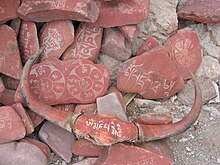

Tibetan art means the art of Tibet and other present and former kingdoms in the Himalayas ( Bhutan , Ladakh , Nepal and Sikkim ). Tibetan art is primarily a form of sacred art that reflects the overwhelming influence of Buddhism in Tibet on cultures across the region. The sand mandala ( Tibetan : kilkhor ) is a tradition from Tibetan Buddhism that symbolizes the ephemeral nature of things. In Buddhism, all materials are viewed as perishable. The sand mandala is an example of this transience and is systematically destroyed after it has been completed and all accompanying ceremonies and exhibitions have ended.
In the 4th century AD, the Mahayana Buddhist school separated and the role of bodhisattvas increased in the arts . These are compassionate beings who forego their own enlightenment to help others. A bodhisattva often depicted in Tibetan art is the deity Avalokiteshvara , usually portrayed as a thousand-armed saint with an eye in each hand. He represents the All-Seeing Merciful One who answers our requests.
Many of the typical Tibetan Buddhist works of art are part of a tantra practice. Vajrayana techniques incorporate many forms of visualization / imagination into meditation, and many of the ornate tantric works of art are actually a visualization aid, such as the meditation deities ( yidams ) or mandalas .
Historians have found that Chinese painting had a huge impact on Tibetan painting in general. Beginning in the 14th and 15th centuries, Tibetan painters adopted many elements from the Chinese, and during the 18th century, Chinese painting had a profound and far-reaching influence on the Tibetan fine arts. According to Giuseppe Tucci , by the time of the Qing Dynasty, "a new Tibetan art had developed which, in a certain form, was the provincial echo of the Chinese equally artistic treasure of the 18th century".
Vietnamese art
Vietnamese art is part of one of the oldest Southeast Asian cultures. The great artistic legacy goes back to prehistoric times and includes silk painting, sculpture, pottery, porcelain making, woodcuts, architecture, music, dance and theater. The spectrum of Vietnamese art ranges from ancient traditional art to works of art that were created after Chinese domination and are strongly influenced by Buddhist art and Taoism as well as Confucianism . The art of Champa and French art also played a role in the further course.
Chinese influence on Vietnamese art extends to Vietnamese pottery and porcelain-making, calligraphy, and traditional architecture.
Beginning in the 19th century, modern art and French influences spread into Vietnamese art. In the early 20th century, the École Supérieure des Beaux Arts de l'Indochine (Indochinese School of Fine Arts) was founded with the aim of teaching European methods. Their influence was particularly evident in larger cities such as Hanoi and Ho Chi Minh City .
During the 80 years of French colonial rule and the long war of independence, many Vietnamese were unable to study or work outside their home country. Only a small number of artists with wealthy origins had the chance to travel to France and for the most part pursue their careers there. Examples are Le Thi Luu, Le Pho, Mai Trung Thu, Le Van De, Le Ba Dang and Pham Tang.
Modern Vietnamese artists have begun to combine French techniques with traditional Vietnamese media such as silk or lacquer, creating a unique mix of Eastern and Western elements.
Asian Art Gallery
Shang dynasty (Yin) ritual bronze wine vessel, 13th century BC Chr., China
Standing Buddha statue , Gandhara ancient region , northern Pakistan , 1st century AD, Guimet Museum
The Buddha statue from Avukana, 5th century, Sri Lanka
Seated Buddha , Gandhara , 2nd century AD
Buddhist sculpture Silla dynasty , 9th century, Korea
The Buddha calling the earth to witness, The Buddha's arms are in bhūmisparsa mudrā position. Ho Phra Kaeo temple, Vientiane , Laos
Phra Achana, Big Buddha statue in Wat Sichum, 13th century Sukhothai period , Thailand
Chinese Zen Buddhist Wuzhun Shifan, 1238 AD, Song dynasty
Song dynasty porcelain bottle with iron pigment under transparent colorless glaze, 11th century, China
Autumn in the River Valley, Guo Xi (ca 1020-1090 AD), China
Gita Govinda manuscript circa 1500, Prince of Wales Museum , Mumbai
Pine Trees, six-sided screen, Hasegawa Tohaku , (1539-1610), Japan
At underworld messenger, Joseon Dynasty , Korea
After Rain at Mt. Inwang, Cheong Seon (1676-1759), Korea
A White-Robed Kannon, Bodhisattva of Compassion, Kanō Motonobu (1476–1559), Japan
Chrysanthemum porcelain vase, Ming dynasty , AD 1368–1644, China
A screen showing Go players, Kanō Eitoku (1543–1590), Japan
Floating Figures Dancing, wall painting , ca.850, India
Utagawa Hiroshige , Snow falling on a town, ca.1833, Ukiyo-e print
Hinduism refers to Buddha (bottom right) as one of the 10 avatars of the Vishnu painting, around 19th century. Century, Jaipur ; Victoria and Albert Museum , London
Stone carving, named Chaityas, can also be seen on street corners and in courtyards in Kathmandu
literature
- Arts of Korea . The Metropolitan Museum of Art, New York 1998,ISBN 0-87099-850-1.
- Welch, Stuart Cary: India: art and culture, 1300-1900 . The Metropolitan Museum of Art, New York 1985, ISBN 978-0-944142-13-4 .
Web links
- Chinese Art and Galleries at China Online Museum
- Asian Art at the Metropolitan Museum of Art
- Freer Gallery of Art and Arthur M. Sackler Gallery at the Smithsonian Institution
Individual evidence
- ^ A b The Meeting of Eastern and Western Art , Revised and Expanded edition (Hardcover) by Michael Sullivan, Publisher: University of California Press; Rev Exp Su edition (June 1, 1989), ISBN 0-520-05902-6 , ISBN 978-0-520-05902-3
- ↑ query.nytimes.com NY Times, Holland Cotter, Accessed online October 27, 2007
- ^ Japonisme: The Japanese Influence on Western Art Since 1858 (Paperback) by Siegfried Wichmann # Publisher: Thames & Hudson; New Ed edition (November 19, 1999), ISBN 0-500-28163-7 , ISBN 978-0-500-28163-5
- ^ Metropolitan Museum of Art, Ancient Near Eastern Art
- ↑ Miguel Covarrubias : Island of Bali . Cassel, 1937.
- ↑ Fred and Margaret Eiseman: Woodcarving of Bali . Periplus, 1988.
- ↑ Hildred Geertz: Images of Power: Balinese Paintings Made for Gregory Bateson and Margaret Mead . University of Hawaii Press, 1994, ISBN 978-0-8248-1679-7 .
- ^ Jean Couteau: Catalog of the Museum Puri Lukisan . Ratna Wartha Foundation (i.e. the Museum Puri Lukisan), 1999, ISBN 979-95713-0-8 .
- ↑ Lindsay Brown: Bhutan . 3. Edition. Lonely Planet, 2007, ISBN 978-1-74059-529-2 , pp. 104 .
- ^ Bhutan: Arts & Crafts . Tourism Council of Bhutan: Government of Bhutan. Archived from the original on June 12, 2010. Info: The archive link was inserted automatically and has not yet been checked. Please check the original and archive link according to the instructions and then remove this notice. Retrieved June 7, 2010.
- ↑ a b McKay, Alex. The History of Tibet. Routledge. 2003. p. 596-597. ISBN 0-7007-1508-8
- ^ Art History - A Brief History Of Vietnam Fine Art . ( Memento of the original from March 4, 2010 in the Internet Archive ) Info: The archive link was inserted automatically and has not yet been checked. Please check the original and archive link according to the instructions and then remove this notice.
- ↑ a b c Huu Ngoc: Modern Painting: Tracing the Roots Archived from the original on March 6, 2012. Info: The archive link was inserted automatically and has not yet been checked. Please check the original and archive link according to the instructions and then remove this notice. In: Thế Giới Publishers (ed.): Vietnam Cultural Window . 29, 2000. Retrieved on April 23, 2010. Full text available here ( Memento of the original from March 27, 2010 in the Internet Archive ) Info: The archive link has been inserted automatically and has not yet been checked. Please check the original and archive link according to the instructions and then remove this notice.

